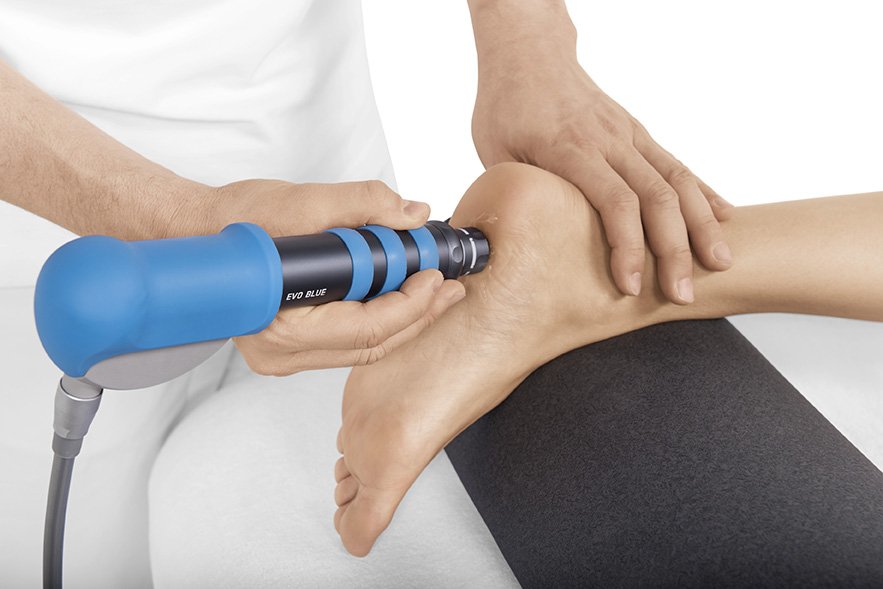
Shockwave Therapy
-
Also known as extracorporeal shockwave therapy (ESWT) or radial shockwave therapy (RSWT)
A non-invasive treatment that uses ballistic acoustic waves to help heal bone and soft tissues such as muscle, ligament, and tendon
Has a treatment depth of 2 inches. Ideal for extremity joints and other superficial structures
What Does It Feel Like?
Unlike high-energy shockwave therapy, RSWT does not require anesthesia during treatment
Typically moderate discomfort (5-7/10 pain) is felt during shockwave therapy, like a repetitive sting. However, the intensity can be adjusted to a degree to keep the treatment within your tolerance. The body does typically acclimate after the first 1-2 minutes.
Mechanism of Action:
Shockwaves stimulate osteoblasts that are cells responsible for bone healing and new bone production
Shockwaves stimulate fibroblasts that are cells responsible for healing of connective tissue
Shockwaves stimulate tenocytes, leading to increased cell proliferation and collagen synthesis, promoting tissue repair and healing within the tendon
This stimulation can result in the release of growth factors like TGF-beta1 and IGF-1, which further promote cell proliferation and collagen production
Stimulate nerve cells, potentially promoting nerve regeneration by triggering cellular processes like the release of growth factors and enhancing blood flow to the affected area, which can lead to improved nerve function and pain relief; however, further research is needed to fully understand its mechanisms on the nervous system
Diminishes pain by two mechanisms:
Hyperstimulation anesthesia – local nerve endings are overwhelmed with so many stimuli that their activity diminishes resulting in short-term reduction in pain
Gate-control mechanism – whereby local nerves are stimulated to recalibrate perception of pain and result in longer-term reduction in pain
Mechanical pressure and tension forces on the tissue increases cell membrane permeability, thereby increasing microscopic circulation and therefore the metabolism within the treated area. This promotes healing and may result in the dissolution of calcific deposits
The pressure front creates behind it a “cavitation bubble” which are small empty cavities created behind a pressure front. When the bubbles collapse they create a resultant force that has a mechanical impact on the treated tissue. This force helps to break down calcific deposits embedded in damaged tissue
Shockwave increases blood flow to the treated area, delivering more nutrients and oxygen to cells, enhancing healing potential
Can disrupt and significantly reduce the bacterial load within a biofilm, making it a potential treatment option for biofilm-related infections, particularly when combined with antibiotics as the disrupted biofilm becomes more susceptible to antimicrobial agents
-
2 times a week for 4 weeks (or around 8 sessions in one month time, & must have at least 3 days off in between treatments)
More severe conditions may need closer to two months of treatment
Many patients experience a significant and immediate reduction in their pain. Some patients will feel results gradually after each treatment
-
Include, But Not Limited To:
Knee pain:- Arthritis, Patellar Tendinosis (jumper’s knee), Meniscal injuries, Quadriceps Tendinitis, Shin Splints
Shoulder pain- Rotator Cuff Tears, Bicipital Tendonitis, Calcific Tendonitis, Capsulitis (frozen shoulder)
Foot pain- Plantar fasciitis, Achilles tendinopathy, Bone Spur, Neuroma
Elbow pain- Lateral (tennis elbow) or Medial Epicondylitis (golfer’s elbow)
Hip pain- Labral tear, Bursitis, Osteoporosis, Avascular Necrosis
Wrist/Hand pain- Carpal Tunnel Syndrome, Stenosing Tenosynovitis (trigger finger)
Enhance bone healing- including Chronic stress/non-union fracture
Arthritic Conditions
Osteopenia, Osteoporosis
TMJ disorders
Lymphedema
Scar Tissue
Back Pain
Nerve Pain
Erectile Dysfunction (not offered at this office)
-






